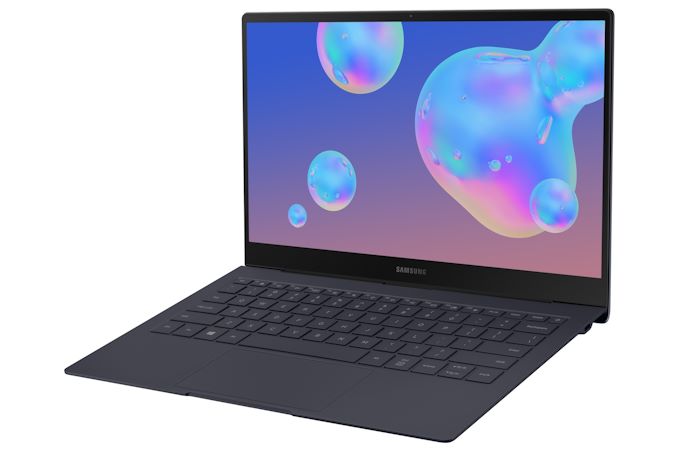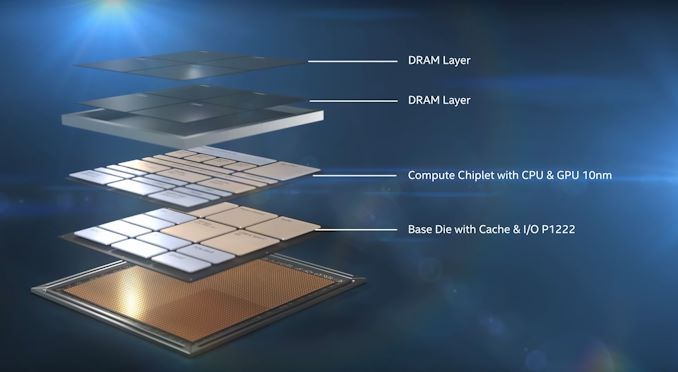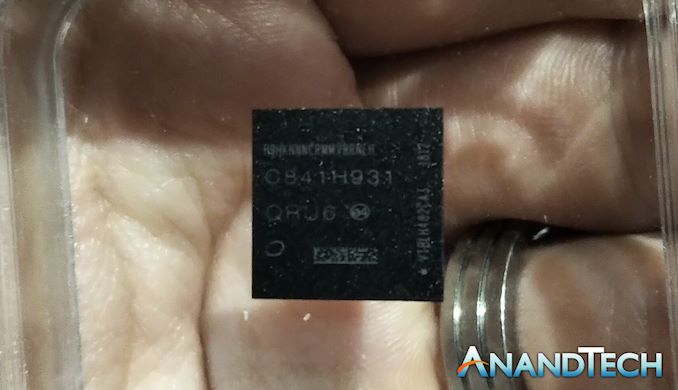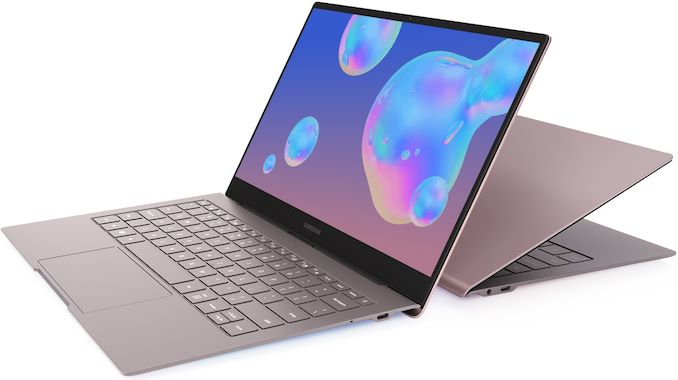Samsung Unveils Intel-based Galaxy Book S: Intel’s Lakefield Inbound
by Ryan Smith on May 29, 2020 11:30 AM EST
Samsung this morning is taking the wraps off of the long-awaited Intel (x86) version of the company’s popular ultraportable, always-connected laptop, the Galaxy Book S. First teased by Samsung late last year, the Intel-based version of the laptop is set to join their existing Qualcomm 8cx-based model, swapping out the Arm SoC for Intel’s latest foray into ultra-mobile processors, Lakefield. The Intel Galaxy Book S will be the first device to ship with Lakefield, putting the new processor to the test in seeing if Intel can match the kind of all-day battery life that the existing Galaxy Book S is known for.
As a quick refresher, for the last couple of years now we’ve been reporting on Intel’s forthcoming die stacked CPU, codenamed Lakefield. Officially called the “Intel Core processor with Intel Hybrid Technology”, Lakefield is a rather audacious chip for a company that’s been criticized for moving too slowly, as it integrates a number of first-time technologies for Intel as they look to deliver a cutting-edge x86-based chip that’s properly suited for the ultra-mobile market.
In terms of architecture, Lakefield is the first hybrid CPU from Intel, combining both the company’s Atom (Tremont) and Core (Sunny Cove) CPU cores on to a single die. This sort of big-little strategy has been a big part of Arm’s success in mobile devices, by offering separate high-performance and low-power cores to maximize efficiency without giving up on higher performance as well, and by incorporating it for their own designs it will mark a significant departure from Intel’s existing Atom-only offerings. At the same time, Lakefield is designed to be vastly more efficient than those earlier Atoms, with Intel aiming to get idle power consumption down to a couple of milliwatts, necessary to allow for devices that can be always-connected/always-on, and to breach the ultra-mobile market largely dominated by Qualcomm.
The other novel aspect of Lakefield is its construction. The chip is based on Intel’s Foveros technology, which is the company’s take on 3D die stacking using TSVs. In the case of Lakefield, Intel has split up the chip into essentially 3 levels, stacked upon each other: a 14nm-built base I/O die that has features like USB an audio, a 10nm-built compute chiplet that has the CPU and GPU cores, and finally a DRAM layer connected using more traditional Package-on-Package technology. This strategy not only lets Intel split up the manufacturing of the chip across multiple process nodes – using cutting-edge 10nm for the compute while using a highly-tuned 14nm node for the base die – but it minimizes the overall footprint of the chip. Lakefield has a footprint of just 12mm x 12mm (and 1mm tall), making the package smaller than a dime.
This chip, in turn, will be making its debut in Samsung’s Galaxy Book S family. Samsung has been shipping a Qualcomm 8cx version of this laptop since earlier this year, using Qualcomm’s ultra-mobile chip to drive the always-connected laptop. Qualcomm has been a major proponent of always-on laptops, leveraging their years of expertise in modems and low-power operation in general from smartphones to apply it to laptops, and with a rated battery life of up to 25 hours, the current Qualcomm-based version of the Galaxy Book S has certainly lived up to those goals.
| Samsung Galaxy Book S Family | ||
| Galaxy Book S (Intel) | Galaxy Book S (Qualcomm) | |
| CPU | Intel Core with Hybrid Technology 1x Sunny Cove (Core) 4x Tremont (Atom) |
Qualcomm Snapdragon 8cx 4x Kryo 495 Gold @ 2.84 GHz 4x Kryo 495 Silver @ 1.8 GHz |
| GPU | Intel UHD Graphics | Adreno 680 |
| Display | 13.3 Inch, 1920×1080 Full HD Touchscreen |
|
| Memory | 8 GB LPDDR4X | |
| Storage | 256/512 GB eUFS + microSD Card Slot |
256/512 GB + microSD Card Slot |
| Networking | Wi-Fi 6 (802.11ax) BT 5.0 |
Wi-Fi 5 (802.11ac) BT 5.0 |
| Modem | Discrete LTE Cat 16 |
Integrated Qualcomm X20 LTE Cat 18 |
| Battery | 42 Wh | |
| Ports | 2 x USB-C 1 x 3.5 mm (phono/mic) |
|
| Dimensions (WxDxH) | 305.2 x 203.2 x 11.8 mm | |
| Weight (Approx) | 950g | 960g |
| Price (USD) | N/A | Starts at $999 |
So with Lakefield intended to go head-to-head with the likes of Qualcomm’s 8cx, there’s no better place for Intel to start than the Galaxy Book S. But this also means that they’ll have a tough fight right out of the gate, as they’ll be going up against one of the better Arm-powered laptops on the market.
Meanwhile, taking a look at the specifications, the Intel-based version of the Galaxy Book S is a spitting image of the Qualcomm version. Samsung appears to be using the same chassis here, so the 13.3-inch laptop retains the same dimensions as the current model, as well as the same two USB-C ports. The battery capacities are identical as well at 42 Wh, and I expect that the Intel model is also using the same 1080p LCD. Curiously though, the Intel model does end up being ever so lighter than the Qualcomm model – Samsung puts the former at 950g, 10g lighter than the 960g Qualcomm model.
As for RAM and storage, because RAM is part of the Lakefield package, Samsung is only offering a single 8GB configuration here. Unfortunately Samsung’s spec sheet doesn’t list memory frequencies, so we’ll have to wait and see what Intel has Lakefield’s memory clocked at. Meanwhile Samsung provides the storage, using 256GB or 512GB of their eUFS flash memory. To my knowledge this is the first x86 laptop to ship with eUFS, reflecting the mobile roots of the devices Intel is targeting with Lakefield. Further storage expansion is then available through a microSD card slot.
One specification that’s notably missing from Samsung’s announcement today is the expected battery life of the Intel-based model, and this is perhaps going to be the most interesting aspect of Lakefield. Intel has worked very hard to get their idle power consumption down to be able to match what Qualcomm has achieved with the 8cx, with the company claiming that Lakefield draws just 2mW at idle. At the same time, however, Lakefield lacks an integrated modem, and as a result Samsung is relying on an unknown Cat 16 external modem here. So in the battle of the Galaxy Books, Qualcomm will have the advantage in regards to requiring fewer chips.
As for other wireless connectivity, the new Intel model will ship with a 2x2 Wi-Fi 6 radio, giving it an edge there over the Qualcomm model with Wi-Fi 5. And both models ship with Bluetooth 5.0 support.
Rounding out the package, the Intel-based Galaxy Book S has a 720p webcam, a built-in microphone as well as Dolby Atmos-badged stereo speakers co-designed with AKG. The laptop also has a Windows Hello-compatible fingerprint reader.
Wrapping things up, with Samsung finally unveiling the full specifications of the Intel-based Galaxy Book S, this is a strong sign that the laptop and Intel’s Lakefield processors should be available soon. While Intel has yet to formally launch the processors, Lakefield’s been expected as a mid-2020 part for some time now, so given this, Lakefield’s launch should be imminent. The precise details of which Samsung seems to be leaving to Intel; at least for the moment, Samsung is not announcing specific availability dates or pricing. Though if it’s at parity with the Qualcomm-based model, then expect the Intel-based Galaxy Book S to start at $999.
Source: Samsung














49 Comments
View All Comments
Tams80 - Saturday, May 30, 2020 - link
No. I'd much rather be somewhat blurry than have someone having to stare up my nose and me have to crane my neck down.boeush - Sunday, May 31, 2020 - link
First, the camera doesn't span the entire (or even most of the) thickness of a modern smartphone; just about half the thickness is taken up by the display, including the glass protecting it.Second, even if it took a camera bump on the laptop's lid to fit in a decent camera with decent optics in, I would bet that's a trade most people would be willing to make without any hesitation. Far more willing, even, than accepting a camera bump on a smartphone.
Third, somehow Apple has no problem fitting half-way decent webcams into its MacBooks. If Apple can do it, certainly other vendors can!
grrrgrrr - Friday, May 29, 2020 - link
Convince apple firstIntelUser2000 - Saturday, May 30, 2020 - link
By the way some laptops don't have a webcam at all. The Ryzen 9 Asus Zephyrus for example has no webcam.PeachNCream - Saturday, May 30, 2020 - link
The webcam will not better than 729p until Lakefield ends up inside a laptop that the manufacturer and tech journalists refer to as a "flagship" device. We all know that anything we call a flagship is the biggest, most powerful-est, and betterer than bestest of the best to sail the seven seas and deliver the weight of its broadside to some unsuspecting coastal fort all while putting up various flags to coordinate the actions of the rest of the fleet because FLAGSHIP!IntelUser2000 - Saturday, May 30, 2020 - link
You forget even $5000 laptops have crappy webcams.PeachNCream - Saturday, May 30, 2020 - link
You forget that any laptop can be referred to as a flagship. I've seen sub-$300 computers advertised on Amazon as flagships. Price does not have anything at all to do with the application of that particular, meaningless term. I'm poking a little fun at Anandtech for falling prey to using it as if it is a defined category.Retycint - Saturday, May 30, 2020 - link
Better sensors are thicker, which precludes them from the thin laptop displays.Regardless, I'm pretty sure a 720p webcam is actually a pro rather than a con because I'm sure nobody wants a 4K60 webcam streaming their pores and pimples to the whole meeting room. People that want to video call their relatives/SO can simply use their phones which will have a much better sensor anyway. So I'm not sure why manufacturers should include a better webcam when the target market doesn't really exist
boeush - Sunday, May 31, 2020 - link
It's not just about resolution. Indeed, resolution is the least of the problems. Far worse, are the high levels of noise, poor color fidelity and contrast, and poor performance in environments that are either too dark or too bright.As for the target market, tons of people are working remotely and/or from home - especially nowadays. Everyone who's ever been in a meeting over Zoom or Teams or GoToMeeting or whatever, is part of the target market.
Ej24 - Monday, June 1, 2020 - link
It's not the camera that's the issue per se. It's the fact that typical x86 processors don't have a dedicated image processing block. Your iPhone and Android phone SOC has a dedicated processing block that handles the data straight from the camera sensors. No x86 cpu has this. It has to travel to the cpu via USB signal (usually 2.0 at best) to brute force with software rather than dedicated hardware. You can put a big ass camera lens and sensor in your laptop but the limitation is the cpu horsepower required to brute force the camera signal. This is why capture cards for video input from cameras are a thing. Your cpu can't handle the data from a camera sensor. Example: I use a capture card with hdmi output from my Sony a7 as a Webcam because the cpu can't handle it otherwise.